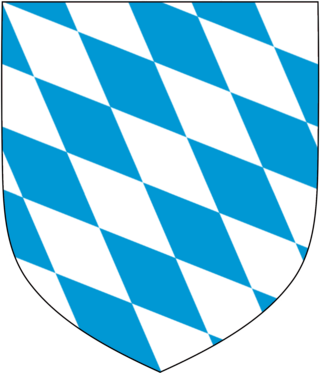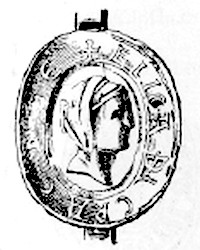
The House of Wittelsbach is a former German dynasty, with branches that have ruled over territories including the Electorate of Bavaria, the Electoral Palatinate, the Electorate of Cologne, Holland, Zeeland, Sweden, Denmark, Norway, Hungary, Bohemia, and Greece. Their ancestral lands of Bavaria and the Palatinate were prince-electorates, and the family had three of its members elected emperors and kings of the Holy Roman Empire. They ruled over the Kingdom of Bavaria which was created in 1805 and continued to exist until 1918.
Otto of Nordheim was Duke of Bavaria from 1061 until 1070. He was one of the leaders of the Saxon revolt of 1073–1075 and the Saxon revolt of 1077–1088 against King Henry IV of Germany.
Gertrud of Brunswick was Countess of Katlenburg by marriage to Dietrich II, Count of Katlenburg, Margravine of Frisia by marriage to Henry, Margrave of Frisia, and Margravine of Meissen by marriage to margrave Henry I.
John, a member of the House of Welf, was Duke of Brunswick-Lüneburg from 1252 until his death. He initially reigned jointly with his brother, Albert the Tall, until the partition of the duchy in 1269, when John became the first ruler of the newly created Principality of Lüneburg.
Adolf III of Berg was count of Berg from 1093 until 1132, and count of Hövel from 1090 until 1106, and Vogt of Werden. He was the son of Adolf II of Berg-Hövel, count of Berg, and Adelaide of Lauffen.

Adolf II of Berg-Hövel (Huvili), count of Berg, count in Auelgau and Siegburg, Vogt of Werden, was the son of Adolf I of Berg.
The Luitpoldings were a medieval dynasty which ruled the German stem duchy of Bavaria from some time in the late ninth century off and on until 985.
Lothair Udo II was Margrave of the Nordmark from 1057 until his death and also Count of Stade. He was the only son of Lothair Udo I of the Udonids and Adelaide of Rheinfelden.
Jutta of Thuringia was the eldest daughter of Landgrave Hermann I of Thuringia and his first wife, Sophia of Sommerschenburg, a daughter of Fredrick II of Sommerschenburg.
Sophia of Hungary, a member of the royal Árpád dynasty, was a Margravine of Istria and Carniola from about 1062 until 1070, by her first marriage with Margrave Ulric I, as well as Duchess of Saxony from 1072 until her death, by her second marriage with Duke Magnus Billung.

Heilika of Pettendorf-Lengenfeld was by marriage Countess Palatine of Bavaria.
Eckhard I of Scheyern, also Ekkehard von Scheyern, was a son of Otto I, Count of Scheyern. His mother cannot be unambiguously determined because Otto I Scheyern was first married to Haziga of Diessen and later to an unknown daughter of Count Meginhardt of Reichersbeuern, and the date of Eckhard's birth is not known.
Otto I, Count of Scheyern was the earliest known ancestor of the House of Wittelsbach whose relation with the House can be properly verified.
Sophie of Winzenburg was the first Margravine of Brandenburg.

Engelbert II, a member of the House of Gorizia, was Count of Gorizia (Görz) from 1150 until his death. At the end of his life, he also held the title of a Margrave of Istria, a Count palatine in the Duchy of Carinthia and Vogt (Reeve) of the Patriarchate of Aquileia.
Haziga of Diessen, also known as Hadegunde was a Countess consort of Scheyern. Her descent is not entirely clear. It is usually assumed that her father was Count Frederick II of Diessen. He was Vogt of the Cathedral chapter in Regensburg. He was married three times; it is unclear in which marriage Haziga was born.

Meinhard II, nicknamed the Elder, a member of the House of Gorizia (Meinhardiner), was ruling Count of Gorizia from 1220 until his death. He also held the title of Vogt (Reeve) of the Patriarchate of Aquileia.
Otto I, Count of Scheyern-Dachau-Valley was a German nobleman. He was a son of Count Arnold I of Scheyern and his wife, Beatrix of Reipersberg. Otto I was the founder of the Scheyern-Dachau-Valley line.
Frederick II of Dießen was a German nobleman. He is documented as bailiff (Vogt) of the Regensburg cathedral chapter in 1035. He is one of the earliest known ancestors of the Counts of Andechs.

Berthold II of Andechs, a member of the House of Andechs, was a German nobleman. He was a ruling count of Dießen and Andechs in the Duchy of Bavaria, of Plassenburg and Kulmbach in Franconia, as well as bailiff of Benediktbeuern Abbey.





